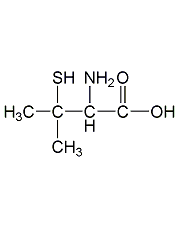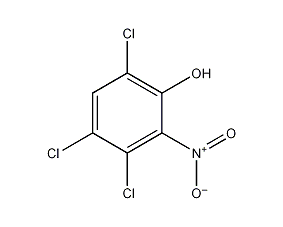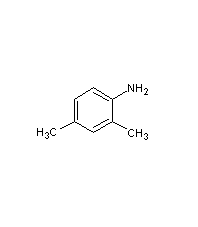
Structural formula
| Business number | 015K |
|---|---|
| Molecular formula | C5H11NO2S |
| Molecular weight | 149.21 |
| label |
?,?-Dimethyl-DL-cysteine, DL-2-Amino-3-mercapto-3-methylbutanoic acid |
Numbering system
CAS number:52-66-4
MDL number:MFCD00004856
EINECS number:200-147-2
RTECS number:YV9445000
BRN number:2039817
PubChem number:24898596
Physical property data
1. Properties: White to off-white crystalline powder
2. Density (g/mL, 25/4?): Undetermined
3. Relative vapor density (g /mL, air=1): Undetermined
4. Melting point (ºC): 208-212
5. Boiling point (ºC, normal pressure): Undetermined
6. Boiling point (ºC, 5.2kPa): 169? (756mmHg)
7. Refractive index: 1.5310
8. Flash point (ºC): 73
9. Specific rotation (º, C=1, sodium hydroxide): -1~1
10. Autoignition point or ignition temperature (ºC): Undetermined
11. Vapor pressure (kPa, 25ºC): 1.68mPa
12. Saturated vapor pressure (kPa, 60ºC): Undetermined
13. Heat of combustion (KJ/mol ): Undetermined
14. Critical temperature (ºC): Undetermined
15. Critical pressure (KPa): Undetermined
16. Oil and water (polymer) Log value of the partition coefficient (alcohol/water): Undetermined
17. Explosion upper limit (%, V/V): Undetermined
18. Explosion lower limit (%, V/V ): Undetermined
19. Solubility: Undetermined.
Toxicological data
1. Acute toxicity: rat oral LD50: 365mg/kg; rat intravenous LD50: 209mg/kg; mouse intraperitoneal LD50: 358mg/kg
Ecological data
None yet
Molecular structure data
1. Molar refractive index: 38.13
2. Molar volume (cm3/mol): 123.8
3. Isotonic specific volume (90.2K ): 326.2
4. Surface tension (dyne/cm): 48.1
5. Polarizability (10-24cm3): 15.11
Compute chemical data
1. Reference value for hydrophobic parameter calculation (XlogP): None
2. Number of hydrogen bond donors: 3
3. Number of hydrogen bond acceptors: 4
4. Number of rotatable chemical bonds: 2
5. Number of tautomers: none
6. Topological molecule polar surface area 64.3
7. Number of heavy atoms: 9
8. Surface charge: 0
9. Complexity: 124
10. Number of isotope atoms: 0
11. Determine the number of atomic stereocenters: 0
12. Uncertain number of atomic stereocenters: 1
13. Determine the number of chemical bond stereocenters.Quantity: 0
14. Number of uncertain chemical bond stereocenters: 0
15. Number of covalent bond units: 1
Properties and stability
None yet
Storage method
This product should be sealed and stored dry at 4°C.
Synthesis method
None yet
Purpose
Biochemical research. Used as a copper ion chelator in Wilson’s disease. Antirheumatic drugs.
extended-reading:https://www.newtopchem.com/archives/182extended-reading:https://www.newtopchem.com/archives/category/products/page/70extended-reading:https://www.bdmaee.net/wp-content/uploads/2022/08/Catalyst-8154-NT-CAT8154-polyurethane-catalyst-8154.pdfextended-reading:https://www.bdmaee.net/trimethyl-hydroxyethyl-ethylenediamine/extended-reading:https://www.bdmaee.net/u-cat-5002-catalyst-cas126741-28-8-sanyo-japan/extended-reading:https://www.bdmaee.net/nt-cat-pc46-catalyst-cas127-08-2-newtopchem/extended-reading:https://www.bdmaee.net/wp-content/uploads/2022/08/Dibutyltin-monooctyl-maleate-CAS25168-21-2-BT-58C.pdfextended-reading:https://www.newtopchem.com/archives/202extended-reading:https://www.newtopchem.com/archives/category/products/page/54extended-reading:https://www.morpholine.org/3164-85-0-2/



